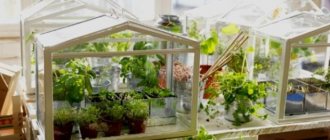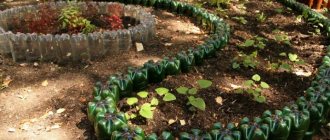Author of the article
Daria Vorontsova
Reading time: 5 minutes
AA
Many varieties and varieties of lettuce can be grown year-round at home.
Green leaves serve as a decoration for prepared dishes and as a basis for salads and sandwiches.
The shoots contain a large amount of vitamins and minerals, while being low in calories.
Growing lettuce on a windowsill requires the use of special knowledge and agrotechnical techniques that allow you to get a good harvest even in winter.
Main types of lettuce
When choosing seeds, preference should be given to varieties for indoor soil with early ripening, resistant to bolting and short daylight hours. The most popular varieties of lettuce that can be grown in an apartment:
- Iceberg . This is the type of salad that chefs use to make Caesar salad. Neat heads of cabbage with crispy, juicy leaves retain their nutritional value and presentation for a long time. Iceberg is cold-resistant and demanding of light and humidity levels. Heads of cabbage reach 8-10 cm in diameter.
- Lettuce . The green or burgundy leaves are collected in a rosette up to 15 cm high. The salad contains a large amount of potassium and iron. The greens have a slight bitterness and a delicate nutty flavor.
- Romano . Loose heads of cabbage with oblong leaves reach a mass of 300 g. The top with wavy edges curls inward. It is used both fresh and after heat treatment. The leaves have a rich taste with a characteristic mustard-nut aftertaste.
- Arugula . The smooth, elongated leaves resemble the shape of a dandelion. Thanks to essential oils, it has a spicy aroma and rich taste. Valued for its high content of vitamin C and iodine. Used for preparing salads and meat dishes.
- Oakleaf (Oakleaf) . Decorative leaves are collected in a spreading variegated rosette. Color varies from soft green to red-brown. Oakleaf is demanding of care and requires a spacious bowl and constant temperature conditions.
Most leafy lettuces go well together in taste, so you can choose several varieties for your home garden on the windowsill. In this case, it is advisable to select varieties with similar requirements for growth conditions.
Which variety grows well at home?
Watercress, called bedbug sativum, is an unpretentious crop. It is resistant to cold, has good frost tolerance down to -3 degrees and loves light. Most varieties are suitable for growing in an apartment and will bring a minimum of worries to novice gardeners.
Depending on the ripening period, early-ripening plants are ready to “share” leaves 15-20 days after germination, mid-ripening ones on 20-30 days, and late-ripening ones last up to 40 days.
Common varieties:
- Whole-leaf (Dukat, Shirokololistny, Ivan da Marya) with a large rosette of foliage up to 20 cm. It has a spicy mustard taste and is used as an ingredient in sauces and gravies;
- Curly with rugged leaves. Popular types: Openwork and Curly Cress. Add to salads and season soups;
- Sowing with slightly dissected leaves. Ideal for growing at home.
You can grow salad greens without soil, using a sponge or cotton wool moistened with a mixture of complex fertilizers.
Lettuce is a favorite dish for vegetarians. The culture is characterized by early ripening, cold resistance and is not demanding on lighting. The following types of lettuce are suitable for growing at home:
- Lollo Rossa. Corrugated leaves from green to burgundy-raspberry shades are used both independently and harmoniously complement meat, fish and vegetables.
- Batavia. It has a slightly sweet taste, perfectly shading cooked dishes.
- Emerald lace. Medium-early, rapidly growing species;
- Sandwich. Early ripening. Pleases with light greens and delicate taste.
- Firebird. It forms large rosettes of a burgundy-red hue and has excellent taste.
You can pamper yourself and your family with fresh herbs in winter by growing other types of salads at home: Iceberg, Maisky, Moscow Greenhouse and Dubrava.
What you need to grow lettuce
In order to start growing lettuce at home, you need to prepare the appropriate container, soil and planting material. The timing of sowing seeds depends on the varietal characteristics of the crop. Light-loving varieties are recommended to be planted in spring and summer. In conditions of short daylight hours, characteristic of autumn and winter, it is better to plant shade-tolerant varieties.
Selection and preparation of containers
The shallow root system of the crop allows you to choose shallow bowls or containers for planting. A mandatory requirement is the presence of holes for excess water to escape.
Ceramic, plastic or clay containers can be used as containers. Before planting, the containers must be washed and disinfected with potassium permanganate. If you want to plant the plant in open ground in the future, you can use peat pots.
At the bottom of the container it is necessary to lay a layer of drainage made of expanded clay, bitumen or small stones.
It is advisable to provide the bowl with a tray into which liquid will drain after watering.
Preparing lettuce seeds for planting
Planting material is purchased in specialized stores, giving preference to reliable manufacturers. When purchasing, you should pay attention to the expiration date of the seeds and the integrity of the packaging. Granulated seeds do not require pre-sowing preparation. All necessary measures have already been taken by the manufacturer. Only self-harvested seeds should be processed. In this case, they are placed in a weak solution of potassium permanganate for 1 hour.
Creating the necessary conditions
Most lettuce varieties need good light. To grow greens at home, choose the sunniest place in the apartment. It is advisable to provide plantings with protection from drafts and sudden temperature changes during the day.
To grow juicy, elastic greens, it is necessary to maintain a high level of air humidity. During the heating season, bowls with lettuce should not be placed close to radiators. The ideal place for a home garden is the kitchen window sill. In the summer months, you can place a container of herbs on a loggia or balcony.
The soil for salad should consist of turf and leaf soil in equal proportions. To loosen it, it is advisable to add coarse sand. It is not advisable to use peat, as it increases the acidity of the soil.
Lettuce growing technology
The future harvest largely depends on well-organized planting of seeds and care of seedlings in the first days after germination. The planting technology consists of the following steps:
- The container with the drainage layer is filled with soil, not reaching 2-3 cm to the top edge;
- The soil is moistened and slightly compacted with a tablespoon;
- Carefully distribute the seeds over the soil surface in accordance with the planting scheme recommended by the manufacturer;
- Sprinkle 0.5 - 1 cm with the remaining soil, spray with warm water from a spray bottle and cover with cling film or glass.
Until the first shoots sprout, maintain the temperature at 20-22 °C. As soon as shoot loops appear on the surface, remove the cover and reduce the temperature to 16-18 °C. Cool air protects the sprouts from being pulled and prevents the formation of flower shoots.
Helpful information
Daria Vorontsova
Amateur gardener. He is interested in growing various greens at home.
The root system of lettuce does not adapt well when transplanted, so it is not picked. To avoid thickening, seeds are sown at the distance indicated on the package.
In conclusion
As you can see, lettuce is not only healthy, but also quite easy to grow. Even on the windowsill you can get a good harvest of greens, thereby diversifying your diet in severe frosts, when vitamins are sorely lacking.
Sources
- https://mir-ovosey.ru/vyrashhivanie-salata-na-balkone/
- https://zifrik.ru/kak-vyrastit-salat-na-podokonnike/
- https://oteplicah.com/rasteniya/419-parnikovyj-salat-moskovskij
- https://openfile.ru/bez-rubriki/%D1%81%D0%B0%D0%BB%D0%B0%D1%82-%D0%BD%D0%B0-%D0%BF%D0%BE %D0%B4%D0%BE%D0%BA%D0%BE%D0%BD%D0%BD%D0%B8%D0%BA%D0%B5-%D0%B2%D1%8B%D1%80% D0%B0%D1%89%D0%B8%D0%B2%D0%B0%D0%BD%D0%B8%D0%B5-%D0%B8%D0%B7-%D1%81.html
- https://balkonsami.ru/interer/ozelenenie/vyirashhivanie-zeleni-na-balkone-i-podokonnike.html
- https://ogorod365.com/posadka-salata-v-2020-godu-sroki-poseva-vyrashhivanie-i-uhod/
[collapse]
Plant care
When 2 true leaves appear on the sprouts, thin out the seedlings. The strongest seedlings are left, with a thick stem and large leaves. If necessary, repeat the procedure after 1 week. As a result, each seedling must have enough area in the bowl for normal development and uniform lighting. It is recommended to rotate the salad container by 45° every week.
Weeds should not be allowed to sprout as they draw most of the nutrients from the soil.
Watering
Timely and abundant soil moisture is the main procedure for caring for greenery. It is necessary to water in the morning, after allowing the water to stand for 24 hours. The roots of the plant should always be in slightly moist soil. Lack of moisture causes the leaves to become bitter. In hot weather and during the heating season, you should spray the ground part with warm water 1-2 times a day.
Top dressing
Leaf lettuce usually has a short ripening period. The nutrients contained in the soil are sufficient to form a full-fledged harvest. In case of slow growth and the formation of thin, pale leaves, you can apply organic fertilizer based on humate. Keep in mind that fertilizing with mineral fertilizers leads to the accumulation of nitrates in plants.
When to Harvest
Harvesting lettuce leaves, depending on the ripening period, can begin 20-40 days after sowing. Marking the desired date on the calendar will become a timely reminder of the upcoming procedure. Main rules:
- homemade greens grow constantly, so after picking off the leaves for the first time, you can continue to harvest from time to time;
- It is advisable to pick leaves in the morning an hour after watering, when they are most saturated with moisture;
- It is better to first cut only those located on the outside of the bushes (3-4 pieces each), without touching the core;
- re-collection is carried out 14 days after the plant is restored, but only until the flower shoots appear.
You can store picked lettuce in the refrigerator for up to 5 days. The product will not lose its texture and taste even when frozen.
Diseases and pests
Salad fly larvae
Aphid
Calcining the soil in the oven
Onion-garlic solution against pests
In apartment conditions, lettuce rarely suffers from pest invasion. Insect damage is possible if garden soil with larvae of lettuce flies or aphids is used. For prevention, you should calcinate the soil in the oven or spill it with a solution of potassium permanganate. If the pest has spread throughout the plantings, it is recommended to spray the leaves with an infusion of garlic or onion peels.
Fertilizing crops
In order to grow lettuce at home on the balcony, it is not at all necessary to fertilize it if a nutritious soil mixture is initially selected. If you are not sure that the soil in which you sowed the seeds is nutritious enough, then your plants should be fed periodically. This is due to the fact that lettuce is a very fast-growing crop. You can use any complex fertilizer or mullein solution for feeding. Mullein must be diluted in a ratio of 1:10. Plants are watered with this solution once a week. This is how you can get salad on the windowsill.











